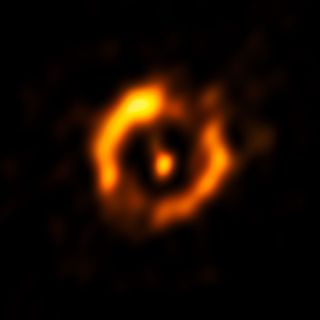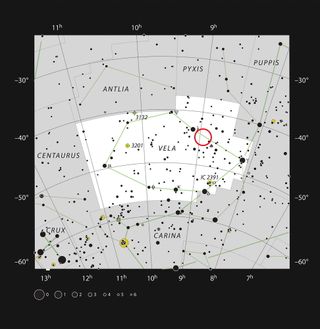Could New Planets Form Around Old Stars, Too? (Video, Images)
Some stars may host multiple generations of planets, a dazzling new photo suggests.
The newly released image, which was captured by the Very Large Telescope Interferometer (VLTI) in Chile, shows a dusty disk around an old double star called IRAS 08544-4431, which lies about 4,000 light-years from Earth in the southern constellation of Vela (The Sails). Scientists created this video look at the dust-shrouded star to showcase the discovery.
This disk is very similar to the planet-forming structures commonly observed around young stars. While it's not clear whether planets actually do take shape around older stars, the new photo — the sharpest ever taken of such a disk around a mature star — hints that this is a possibility, researchers said. [The Strangest Alien Planets (Gallery)]
"Our observations and modeling open a new window to study the physics of these disks, as well as stellar evolution in double stars," study co-author Hans Van Winckel, of the Instituut voor Sterrenkunde in Belgium, said in a statement. "For the first time, the complex interactions between close binary systems and their dusty environments can now be resolved in space and time."

The scientists used several VLTI telescopes, an associated instrument called the Precision Integrated-Optics Near-infrared Imaging ExpeRiment (PIONIER) and a new high-speed infrared detector to take the photo.
"We obtained an image of stunning sharpness — equivalent to what a telescope with a diameter of 150 meters [490 feet] would see," study team member Jacques Kluska, of Exeter University in England, said in the same statement. "The resolution is so high that, for comparison, we could determine the size and shape of a 1-euro coin seen from a distance of 2,000 kilometers [1,240 miles]."
The IRAS 08544-4431 system consists of an old red giant star, as well a nearby, younger, "normal" star. The dust that comprises the newly imaged disk was expelled by the red giant, researchers said.
Get the Space.com Newsletter
Breaking space news, the latest updates on rocket launches, skywatching events and more!

"We were also surprised to find a fainter glow that is probably coming from a small accretion disk around the companion star," said study lead author Michael Hillen, also of the Instituut voor Sterrenkunde.

"We knew the star was double, but weren't expecting to see the companion directly," Hillen added. "It is really thanks to the jump in performance now provided by the new detector in PIONIER, that we are able to view the very inner regions of this distant system."
Hillen and his colleagues are publishing their results in the journal Astronomy & Astrophysics.
The VLTI is located at the European Southern Observatory's Paranal Observatory in northern Chile.
Follow Elizabeth Howell @howellspace, or Space.com @Spacedotcom. We're also on Facebook and Google+. Original article on Space.com.
Join our Space Forums to keep talking space on the latest missions, night sky and more! And if you have a news tip, correction or comment, let us know at: community@space.com.

Elizabeth Howell (she/her), Ph.D., is a staff writer in the spaceflight channel since 2022 covering diversity, education and gaming as well. She was contributing writer for Space.com for 10 years before joining full-time. Elizabeth's reporting includes multiple exclusives with the White House and Office of the Vice-President of the United States, an exclusive conversation with aspiring space tourist (and NSYNC bassist) Lance Bass, speaking several times with the International Space Station, witnessing five human spaceflight launches on two continents, flying parabolic, working inside a spacesuit, and participating in a simulated Mars mission. Her latest book, "Why Am I Taller?", is co-written with astronaut Dave Williams. Elizabeth holds a Ph.D. and M.Sc. in Space Studies from the University of North Dakota, a Bachelor of Journalism from Canada's Carleton University and a Bachelor of History from Canada's Athabasca University. Elizabeth is also a post-secondary instructor in communications and science at several institutions since 2015; her experience includes developing and teaching an astronomy course at Canada's Algonquin College (with Indigenous content as well) to more than 1,000 students since 2020. Elizabeth first got interested in space after watching the movie Apollo 13 in 1996, and still wants to be an astronaut someday. Mastodon: https://qoto.org/@howellspace
